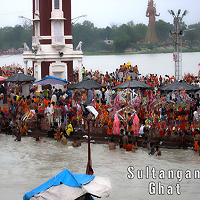Deoghar, Jharkhand
Sultanganj Tourism
 |
Sultanganj- The land of Lord Shiva & Buddha and a notified area in Bhagalpur district in the Indian state of Bihar. It is situated on the south bank of Ganga river. The Temple situated at Sultanganj in Bhagalpur District, Ajgaivinath temple is dedicated to Lord Shiva. It is believed that the deity of the temple is Swayambhu. The temple is constructed on a rock and has a series of excellent rock sculptures and inscriptions. The sculpture dates back to the Pala period. The splashing waters of the Ganga sanctify the area.
The temple is solidly built on the rock and has got a series of marvelous rock sculpture and some inscriptions. Some of the specimens of the rock panel sculpture at this temple can hold their own against any of the best known specimens anywhere in India. Not much study, unfortunately, has been made of the rock sculpture and inscriptions here. The sculpture could be taken to be of the later Pala period The site is very attractive and, particularly during the rainy season, the splashing waters of Mother Ganga wash the feet of the temple. sultanganj-ajgaivinath-mandir The name Jahangira for the rock had continued till at least1824-25, when Bishop Heber visited the area. In Heber's Journal, Vol. 1, there is a pencil sketch of the temple on the rock tinder the caption of Jahangira. The pencil sketch depicts a mosque by the side of the temple. It is commonly said that Kala Pahar, in the course of his crusade against the Hindu temples, visited the place. He tried his best but failed to demolish Ajgaivinath temple.
Like many of the ancient temples, the origin of Ajgaivinath temple is also shrouded in mystery. According to one legend, Lord Shiva was given his bow here, known as Ajgav, and so the place came to be known as Ajgaivinath. The ancient name of the place was Jahangira, which was derived from the name of Jahnu Muni. Jahangira is a distorted form of Jahnu giri (the hill of Jahnu) or Jahnu griha (the abode of Jahnu). It is traditionally associated with the sage Jahnu, whose ashram was a centre of learning and culture. Jahnu Muni's ashram was located on the rock jutting out of the bed of the Ganga River. Now the site has the Shiva temple of Ajgaivinath, also known as Gaibinath Mahadeo. The story is that the river Ganga on her way to the ocean interrupted the Muni in his meditation by the rush of her currents. The sage swallowed the river in a gulp. Bhagiratha intervened and the Muni again let her out by making an incision in his thigh. That is why the river Ganga is also called Jahnavi.
The temple is solidly built on the rock and has got a series of marvelous rock sculpture and some inscriptions. Some of the specimens of the rock panel sculpture at this temple can hold their own against any of the best known specimens anywhere in India. Not much study, unfortunately, has been made of the rock sculpture and inscriptions here. The sculpture could be taken to be of the later Pala period The site is very attractive and, particularly during the rainy season, the splashing waters of Mother Ganga wash the feet of the temple. sultanganj-ajgaivinath-mandir The name Jahangira for the rock had continued till at least1824-25, when Bishop Heber visited the area. In Heber's Journal, Vol. 1, there is a pencil sketch of the temple on the rock tinder the caption of Jahangira. The pencil sketch depicts a mosque by the side of the temple. It is commonly said that Kala Pahar, in the course of his crusade against the Hindu temples, visited the place. He tried his best but failed to demolish Ajgaivinath temple.
Like many of the ancient temples, the origin of Ajgaivinath temple is also shrouded in mystery. According to one legend, Lord Shiva was given his bow here, known as Ajgav, and so the place came to be known as Ajgaivinath. The ancient name of the place was Jahangira, which was derived from the name of Jahnu Muni. Jahangira is a distorted form of Jahnu giri (the hill of Jahnu) or Jahnu griha (the abode of Jahnu). It is traditionally associated with the sage Jahnu, whose ashram was a centre of learning and culture. Jahnu Muni's ashram was located on the rock jutting out of the bed of the Ganga River. Now the site has the Shiva temple of Ajgaivinath, also known as Gaibinath Mahadeo. The story is that the river Ganga on her way to the ocean interrupted the Muni in his meditation by the rush of her currents. The sage swallowed the river in a gulp. Bhagiratha intervened and the Muni again let her out by making an incision in his thigh. That is why the river Ganga is also called Jahnavi.
Holiday Packages
Contact Us
Aadarsh Tour and Travels
C/o Sanjay Singh, Kumudini Ghosh Road, Barmasia, Deoghar, Jharkhand - 814112, India
Mobile : +91-6202358687, 7870790292
Call Us : 08048401973
E-mail : aadarshtourandtravels2017@gmail.com

